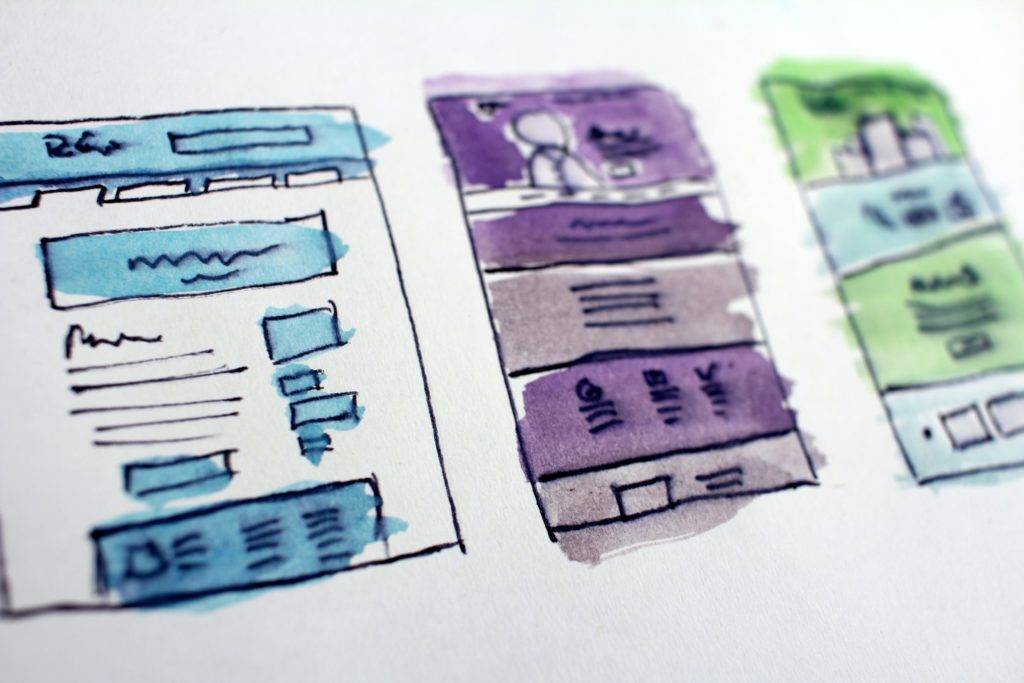Stagnation in your sales pipeline is one of those things that can creep up on you. When it happens, it feels impossible to get rid of, like back pain after 35.
One moment, you're ambling along merrily with customers you actually like (gasp!) and a conversion ratio that doesn't make you want to curl into a ball and weep, and the next, you're dealing with leads from hell, a frustrated sales team, and deals that would qualify as exhibits in the Neanderthal section of your local museum.
In the absence of a time travel machine or a magic wand, we can't offer you a way to turn it all back, but we do have the next best thing: a way forward.
In this guide, we'll walk you through each step of the sales process, from lead generation to customer retention, and examine proven sales tactics you can use to diagnose issues, plug every leak in your pipeline, and restore it to its former glory—maybe even surpass it.
Key takeaways
- Sales pipeline stagnation is akin to chronic back pain, sneaking up and hard to alleviate.
- Prospecting is crucial; regularly update ICPs and buyer personas for lead gen.
- Personalized outreach and research are key to engaging and converting prospects.
- Use lead qualification frameworks like BANT or CHAMP to prioritize efforts.
- Craft proposals with personalization, visuals, and options to address client needs.
Prospecting
Prospecting is the first stage of the sales cycle and the potential source of all your problems. It’s where you decide who you want to do business with, what they look like, and how you will find them.
The answers to these questions vary for each business, and they change with time. If you haven’t revisited your prospecting process in a while, or if you want to enhance it, this is your sign to block some time to tackle it.
1. Define ICPs and buyer personas
ICPs (Ideal Customer Profiles) and buyer personas form the building blocks for identifying and attracting qualified leads. These two concepts are often used interchangeably, but they aren't the same thing.
Your ICP addresses broader questions such as those about:
- The lead’s industry
- The size of their company
- Its location
- Their pain points
- How they research products
- Their Customer Lifetime Value
- The value proposition
- Market trends and demands
Conversely, your buyer persona is more detailed and creates fictionalized identities of your product's end users and decision-makers.
They consider factors like:
- Job title - As well as the specific role, and responsibilities
- Demographics - Their age, gender, educational qualifications, socioeconomic status
- Psychographics - Their personal and professional goals, interests, activities, and lifestyle choices
- Behavior - Their preferred channel of communication, their predisposition towards brand loyalty, product quality, and price sensitivity, their objections and concerns
Together, the ICP and buyer persona aid marketing and sales teams in creating promotional and transactional material.
2. Build a target list
Use your CRM system, your website visitors, and other data analytics to build a target list of prospects. Then, compare the people on the list to the ICP and buyer persona you made in the previous step.
The purpose of making a ‘target’ list is to prioritize those accounts with the highest conversion chances. The list is further segmented into niche categories based on industry, location, size, etc.
Depending on the volatility of market conditions and the barriers of entry for new players, update and expand your target list at fixed intervals (more frequently for fast-paced sectors).
3. Research your prospects
Next, you'll do a little stalking. Your research should include looking at both the organizational level and the individual level (your would-be client).
At the organizational level, you're looking for things like:
- A recent round of funding
- Change in management
- Hiring policies
- From the news, their LinkedIn and Twitter page
At the individual level
- Promotions
- Recent experiences and challenges
- Where they went to school or previous roles
- Mutual connections
- Their hobbies, interests, role models
The information you gather here will be used to enhance your personalization efforts during the next steps of the sales process.
The research stage culminates in finding contact information for each company and the point person you’ll communicate with. You can either do this manually by visiting their social media profiles or company websites or using email-finding software that crawls the internet to track down individual email addresses.
All you need to do is fill in the individual’s name and company domain. Hunter’s email lookup tool will serve up their email address.
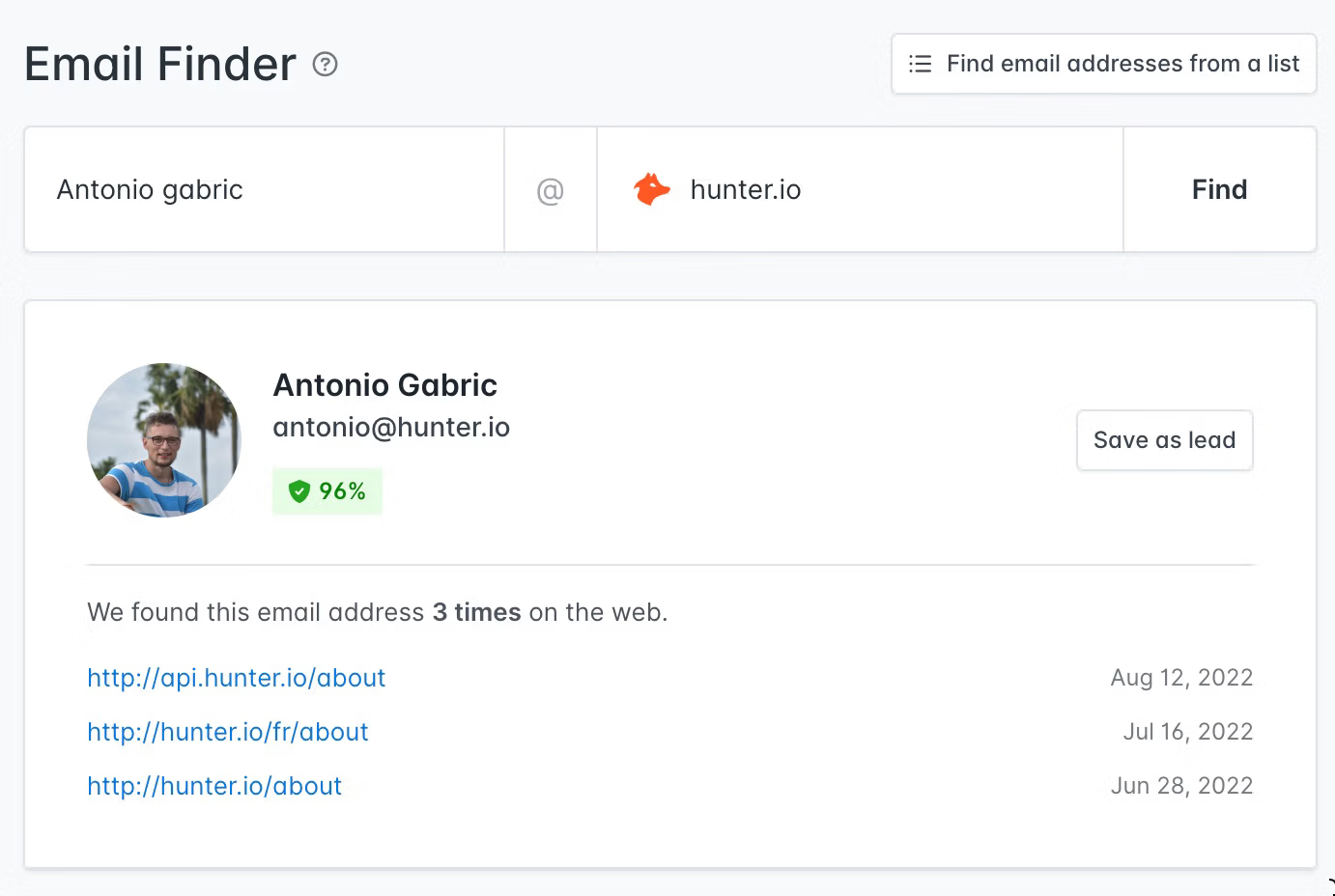
It’s prudent to also run a company-wide search and shortlist one or two alternative contacts using the domain search option in case you run into a dead-end with the initial point person.

4. Craft your outreach
For the lead to take the bait, your offer has to be suited to their specific attributes and needs at each stage of the buyer’s journey.
When making initial contact, avoid using a bad cliche or sales gimmick, go back to the research you've already done, and introduce yourself with a personal touch.
Let’s say you’re a digital marketing agency that works with healthcare startups. Your ToFu (top-of-funnel) content can offer collateral like free checklists and quizzes that help them determine current performance vis-a-vis their potential.
MoFu (middle-of-funnel) offers could include case studies of customers from the same city as them or expert interviews with industry leaders you know they follow on social media. Lean on your content marketing peers to ensure you have a robust library of case studies to choose from.
Offers to mature leads could have discounted rates or special packages if they’re smaller start-ups waiting for funding. If they’re rapidly expanding, offer them enterprise-level solutions or more customized packages.
The bottom line: You need to create customized offers for each lead segment to drive conversions.
5. Make contact with prospects
Depending on the lead’s industry, age, and location, they could be active on LinkedIn or prefer to be contacted via email. You could also simply get their phone number and call them (I know, this is a foreign concept to those of you who belong to Gen Z).
Before you contact them, verify that you’re reaching out to the right person. People change organizations, companies get new domains, and email addresses become defunct.
Validate contact information using Hunter.io by:
- Cross-checking their current role on LinkedIn and
- Running their email address through the email verification process.
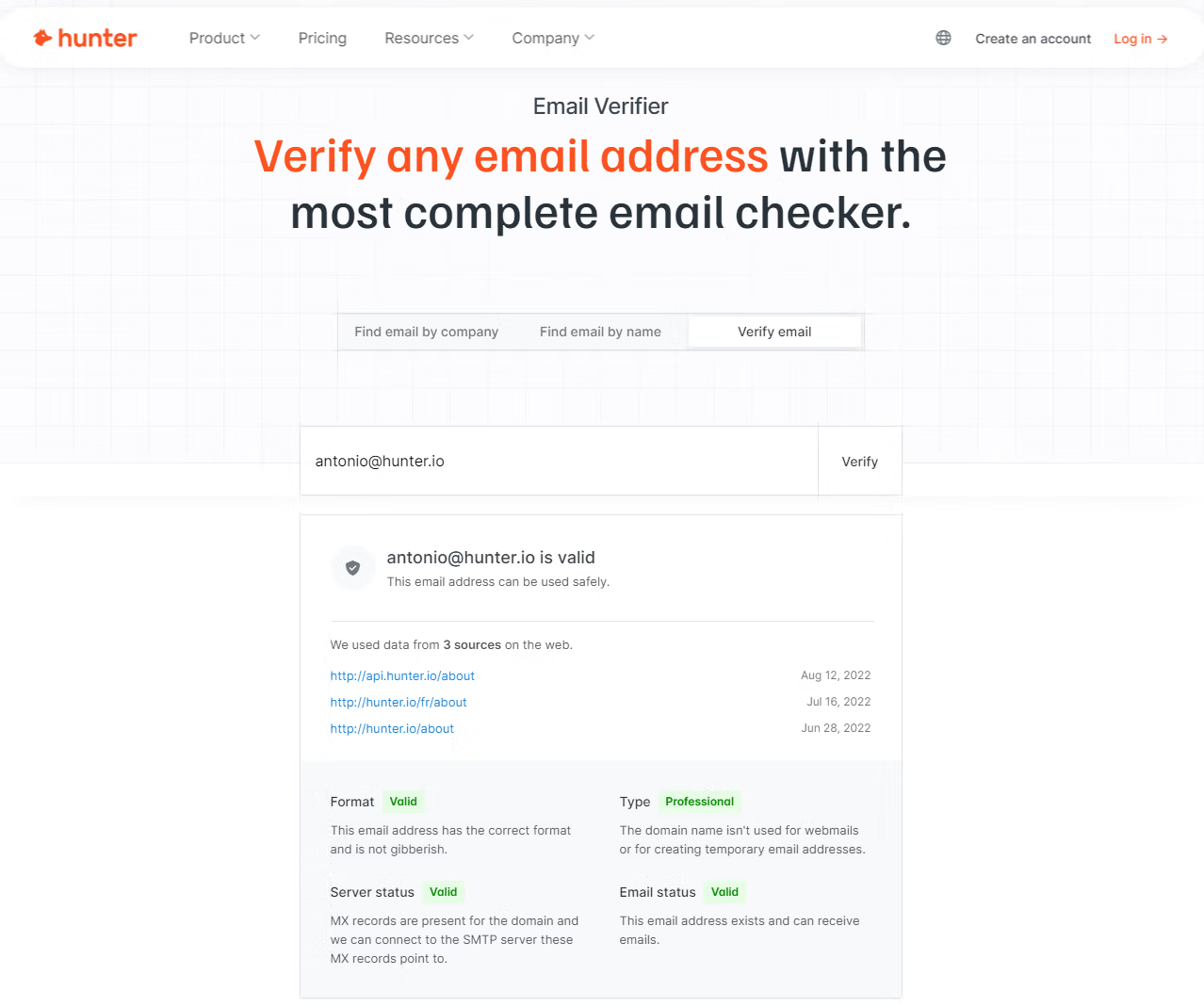
Whether it’s a connection request on LinkedIn or a cold email, initial messaging should focus on providing value and establishing trust.
Use segments and personal details to send out highly personalized messages.
Address them by name and reference specific details relevant to their business or industry. Mention recent achievements, challenges, or opportunities they may be facing.
Personalized videos created with tools like Riverside can help you break through the noise and connect with leads.
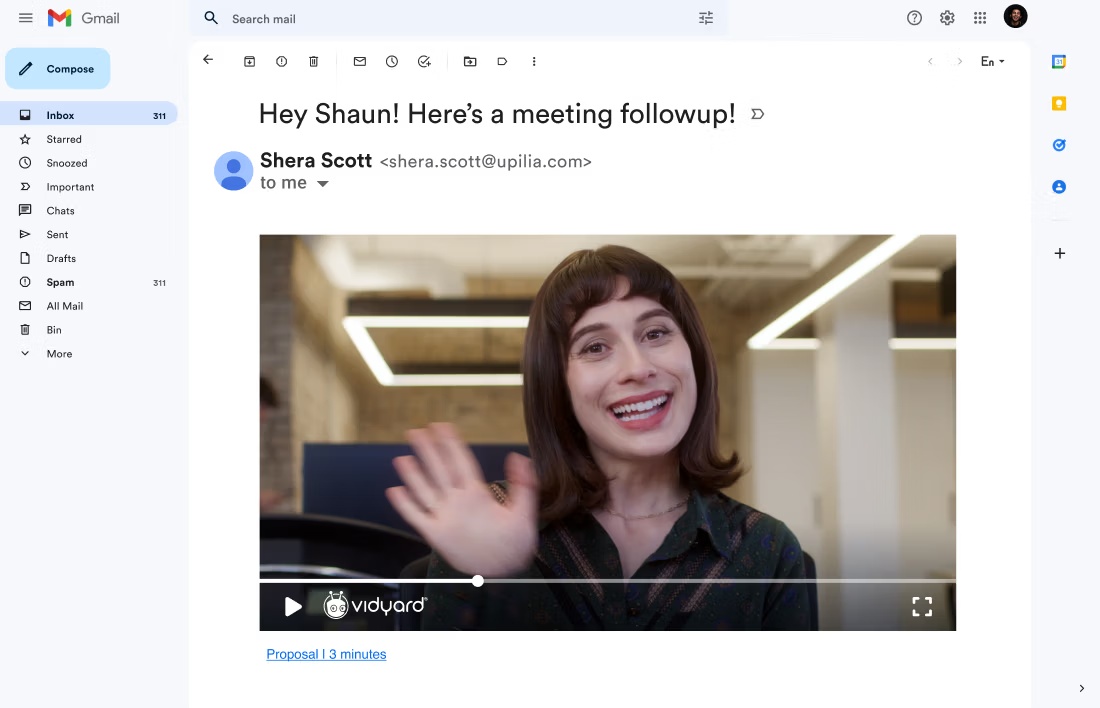
You can also use a multi-touch approach incorporating different communication channels, such as email clients, text messages, or direct mail, to increase the chances of getting a response.
Qualification
Lead qualification provides direction and clarity to what could otherwise be a wild goose chase.
At first glance, a lead may look ideal. But it’s only when they’ve been qualified according to tried-and-tested parameters can you justify spending hundreds of working hours wooing them and the opportunity cost of not chasing other potential candidates.
6. Chose a lead qualification framework
There are several ways to qualify sales leads, and your methodology depends on your business model, industry, sales landscape, and lead volume. Some of the most popular lead qualification frameworks include:
1. BANT - BANT is a straightforward framework for straightforward deals. If you have leads with specific needs and budgets, assess them according to:
- Budget - Do they have the budget for your solution?
- Authority - Are you talking to the person with the power to say yes to the deal?
- Need - Have they established a need for your solution?
- Timing - Are they ready to buy, and if not now, when?
2. CHAMP - This is similar to the BANT framework, but the focus here is not just on closing the deal, but improving audience understanding. It measures leads by their:
- Challenges
- Authority
- Money
- Priority
3. SPIN - This is the third framework on our list where audience understanding is prioritized. It enables sales professionals to ask incisive questions to leads about their
- Situation
- Problem
- Implication (causes and effects of problems)
- Need-Payoff (Why they need your product),
This framework also allows the sales rep to offer the guidance necessary to make the right decision.
4. MEDDIC/MEDDPICC - While all these frameworks are highly adaptable, MEDDIC is especially suited to longer, complicated B2B sales cycles. The MEDDIC acronym stands for:Metrics (gains expected from using the product), Economic buyers (Are you talking to the right person?), Decision criteria, Decision process, Identify pain (consequences of foregoing the product), Champion (the internal advocate),
MEDDPICC, has additional qualifiers which include:
- Paper Process (procedural and legal formalities for deal closure)
- Competition (internal competitors vying for the same funding)
- Compelling event (did something happen to compel this need for change?)
5. GPCT/GPCTBACI - These facilitate a deeper understanding of target audiences by studying their:
- Goals
- Plans
- Challenges
- Timeline
GPCTBACI also considers:
- Budget,
- Authority
- Negative Consequences (of not achieving goals)
- Positive Implications (of achieving goals)
to ensure you’re left only with high-intent leads.
7. Decide on lead scoring criteria
Lead scores are derived by assigning numerical values to different criteria such as demographic information, engagement level, buying signals, and fit with the ICP.
Use the framework you've chosen to assign scores to each category and sub-category of qualifiers.
This includes
- Budget
- Industry
- Company size
- Urgency
- Prospect's buying authority
- Website visits
- Decision process
- Number of meetings, etc.
Factor in past customer experiences and industry trends while deciding the weight of each criterion. For example, you should want a lead with a big budget, a high level of urgency, and a relatively straightforward decision process to score higher than a lead with a moderate budget, complex decision process, and smaller company size.
Check out our video on hidden buying signals you could be missing:
8. Gather & research your leads
Your sales pipeline is only as good as the quality of leads in it. These leads usually come from multiple sources — blog content, LinkedIn, paid ads, etc. You could also have a unique pool, such as referrals or trade workshops, that has generated some of your best leads. But before you start actively pursuing them, determine whether they're worth the next few weeks or months of outreach.
Once you have a list of qualified leads rounded up, its time to do some more digging. Check the social media activity on both their company and individual accounts. Which platform are they the most active on? Do they use emojis? These little details can aid personalization efforts.
You can also integrate data enrichment tools with your CRM to keep track of different touchpoints, including website inquiries, social media interactions, and networking events. All of these pieces of information can help you gauge their interest and adjust the lead scoring as you gather more interactions (or lack thereof).
9. Ask qualification questions
At the qualification stage, you’ve moved past basics, such as the software leads are using or their expectations of your product.
Create questions to assess the lead's requirements, budget, timeline, and decision-making process to assess their suitability as a potential customer. Together, they should let you ascertain the likelihood of purchase and in turn, assign or adjust their lead scores.
These questions can either be direct, like, "Who makes buying decisions at your company?" Or they may be more indirect, for example, "What is your current role in your organization?"
Other questions you may wish to work into early conversations include:
- "What specific features or capabilities are most important to you in a {product/service}?"
- "What is your budget range for addressing {specific problem}?"
- "When are you looking to implement its solution?"
It's up to you to prepare an extensive list based your the qualification framework. Analyze responses and ask follow-up questions to clarify or delve deeper into specific areas of interest.
11. Score your leads and review the data you've collected
Score and segment leads based on their company size, budget, the immediacy of their need for their product, their source, etc.
For example, if the lead in question is a referral, and based on past customer data, you’re aware that referrals close at twice the speed of leads from other sources, assign them a higher score, and put them on the sales team’s priority list.
Periodically review the data collected from the lead qualification questions to refine lead qualification criteria and adjust the lead scoring system as needed.
This data can also help identify patterns, trends, and common characteristics among high-quality leads to further optimize your sales strategy and boost your pipeline.
Proposal
Not all qualified buyers mature at the same pace. Your sales team has to consider engagement levels, needs, and current rapport before deciding to make a pitch or send a formal proposal.
When writing a proposal, you want to ensure you're customizing for each lead and your proposal contains, at the very least:
- The details of your offer
- How your offer will impact your prospect's goals or bottom line (The ROI)
- Pricing
- Competitive advantages and differentiators
12. Make it personal
You cannot afford to let the lead think they're just another name on a list for you. Personalize both the email containing the proposal and the proposal itself with details about the recipients and their organization.
Right off the bat, this sample Qwilr proposal references the last meeting with the client.
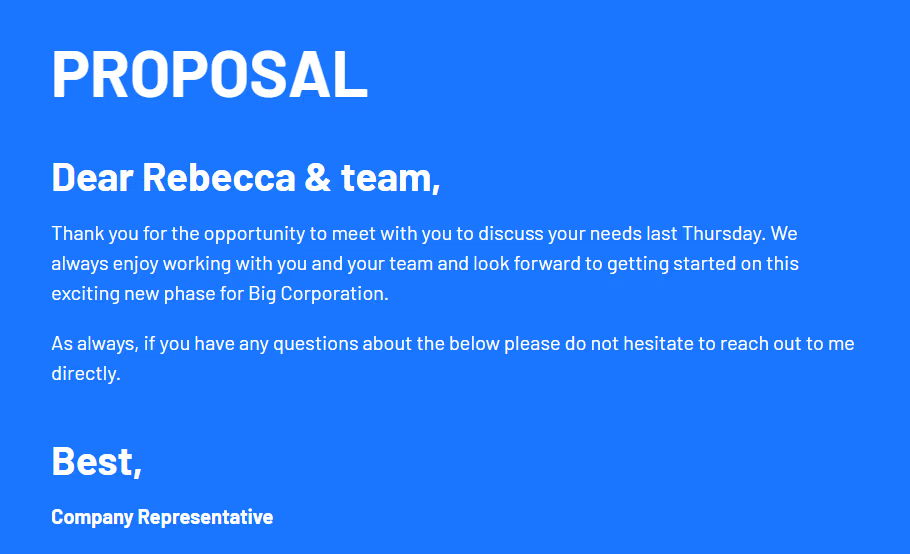
It outlines the proposal's scope and prioritizes the prospect’s goals before launching into all of the details.
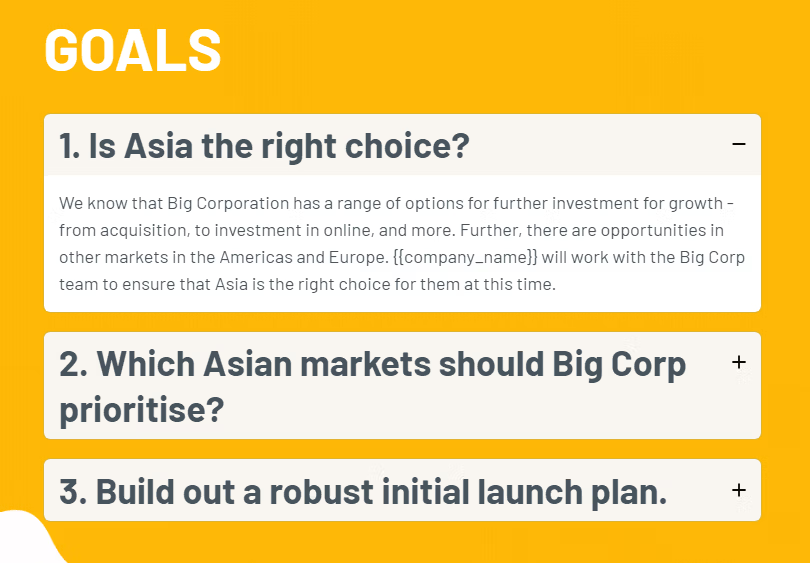
But there’s more to personalization; as they say, the devil is in the details. Send your proposal at a time based on the lead’s location, working hours, and past responses.

Create your proposal as a web page instead of a document. This way you can use analytics to track when the proposal has been viewed and shared within the organization. Qwilr's analytics capabilities are especially robust. Allowing sellers to see who is looking at their proposal, what specific content they're engaging with, when and for how long.
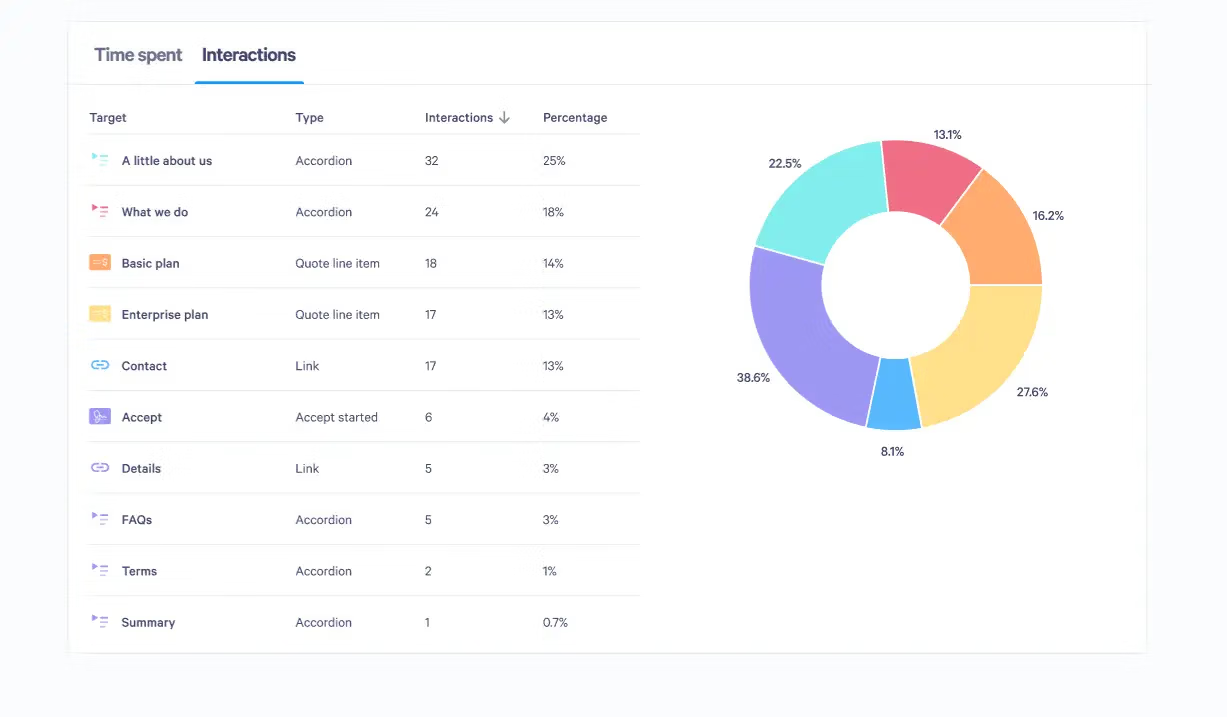
If notifications are turned on, sales reps can follow up with the prospect at the perfect time to close the deal.
13. Leverage the power of visuals
Visuals are powerful tools for persuasion. They’re eye-catching, offer an alternative means of conveying information, and break down complex data. If you thought finance presentations were insufferable, imagine them without the pie charts and graphs...
If your product or service itself is a visual one, using visual elements in the proposal is a no-brainer.
This interior design proposal contains gifs, images to provide a style overview, and an embedded portfolio video.
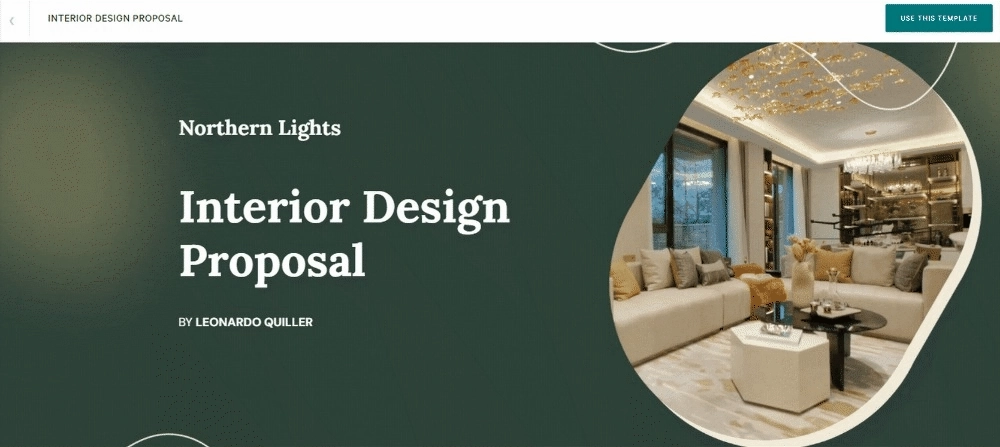

A video walk-through also comes in handy when dealing with multiple decision-makers or a contact person with limited authority. It ensures the context isn't lost or details overlooked if multiple people need to weigh in or negotiations drag on.
14. Offer options
No matter how many hours you've spent answering questions and figuring out what clients want, selling remains an imprecise science.
Instead of presenting a buyer with a ‘take it or leave it’ proposal, offer them more than one option. Multiple options give prospects the feeling of control over pricing and features.
Draw up a comparison table as shown in this template,
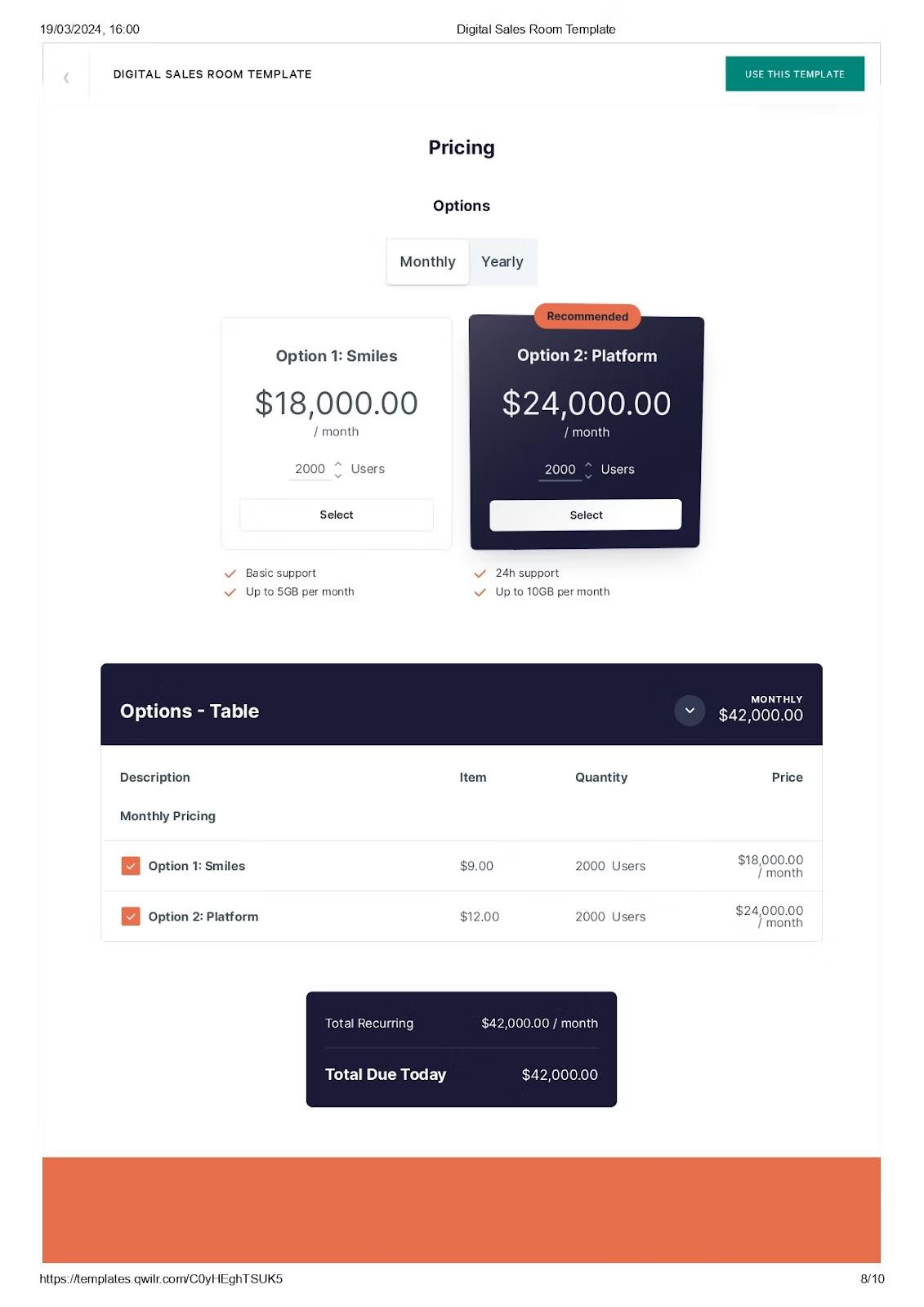
Or, consider recommending an option based on your understanding of their requirements. If you go this route, leave room for scaling your offer up or down as dictated by your prospects needs and budget.
15. Include social proof
How many times have you found yourself getting a haircut, picking a car model, or choosing a landscaper or other service provider because it worked for someone else?
In effective sales, reps consider social proof like case studies and testimonials as a powerful tactic to connect more deeply with prospects. Its a way to show instead of just telling.
Instead of a single page, filled with testimonials or other variation on social proof, you may want to place testimonials or even short case studies in other sections highlighting a particular feature of your product. Add information about the client, such as their industry, position, size, and location, to help your potential buyers relate to them.
16. Offer a solution
If you want prospects to feel truly seen and heard by you, start the proposal by listing their biggest challenges. Explain their current predicament and how it's undermining their potential, and then offer a way out.
This email marketing proposal takes prospective buyers through their operational shortcomings early in the document.
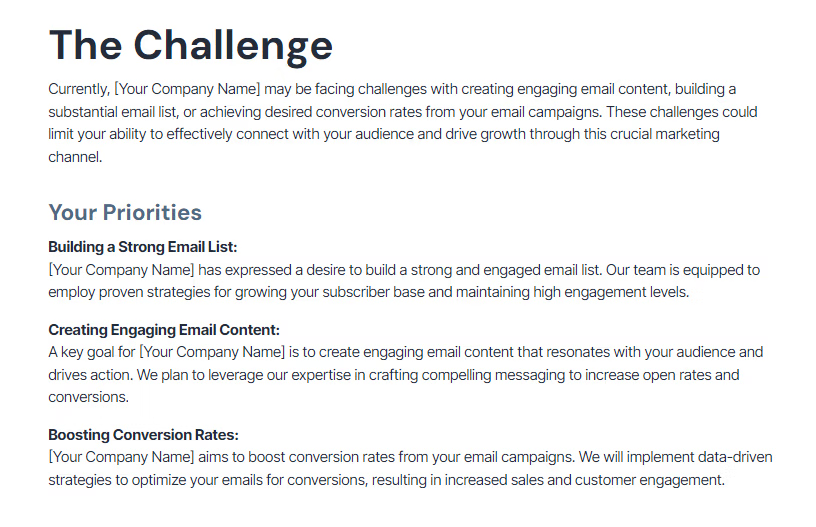
Then, it helps them visualize the result of using your product or services (the new way forward).
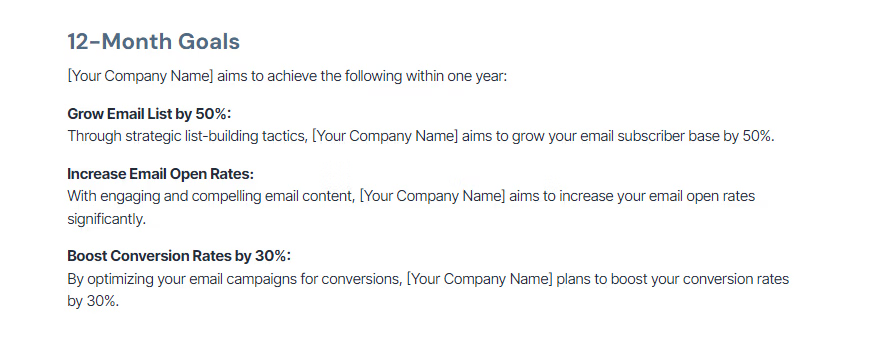
Further down the proposal it gets much more prescriptive. It lays down a roadmap for getting those results.
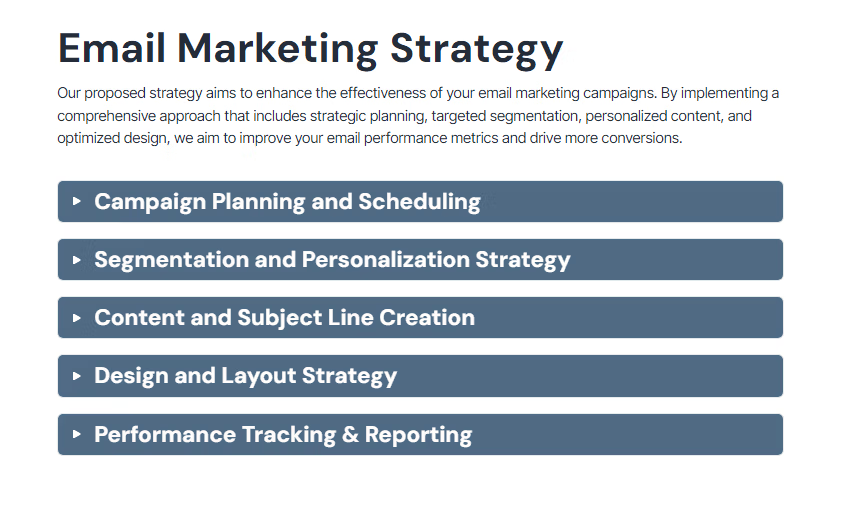
17. Proofread, and then proofread again
Before you hit send on your proposal, one really effective tactic you can use to catch any errors is read your proposal out loud.
If you have time, you should also ask a colleague to give your proposal a read with fresh eyes.
Remember, proofreading isn’t limited to weeding out spelling, grammar, and formatting issues.
You're also looking for irregularities in tone, voice, structure, and flow. This is a good time to ensure your document contains clear headings, detailed explanations and the appropriate summaries for important sections. You also want to make sure you aren't using any high-pressure sales tactics as a way to avoid deeply connecting with your prospect's needs.
Negotiation
After presenting the proposal, you'll have to assume there will be some negotiations. Your prospect is unlikely to take the first offer you throw out. They might need more features and specifications, and you’ll have to address any objections, concerns, or requests for modifications.
For successful sales, you do need to close your deal, so you don't want to fall into the trap of never ending negotiations.
18. Ask open-ended questions
Customers often unwittingly disguise their chief requirements and objections. As long as their original doubts remain unaddressed, they're going to keep circling back, holding up the deal, or even calling it off. Asking open-ended questions leaves them free to word their inhibitions and could give you important clues to arrive at a resolution.
These questions should help you get to the root cause of any objections or suss out any needs that may not have been clear from initial conversations before the proposal was sent.
19. Validate their objections
The easiest way to rub a prospect off the wrong way is by negating or downplaying their objections. So it's critical that you take the opposite approach.
Validate objections by following a three-step process.
1. Empathize.
Actively listen when a buyer raises doubts about the offer. Acknowledge the truth of what they're saying and make them feel you're on their side.
2. Cite similar examples.
Talk about other clients who have expressed the same concerns and why they still went ahead with the purchase. Back it up with facts and statistics.
3. Move forward with ‘yes and…’.
Don't let conversations stall after objections are discussed. Offer them an alternative perspective, and keep things moving, like this template here.
![a screenshot of a text message that says but [ objection ]](https://cdn.sanity.io/images/vhpgdzfc/production/c80d41dda97730e453cf01ab43a8a9e57faf5440-712x488.png?q=100&auto=format)
Remember, most objections aren't rejections, but requests for additional information.
20. Reframe the objection
Let's say a potential customer has expressed reservations about the pricing. If you see it as a barrier to the sale, you'll end up taking a defensive stance and might lose an already flighty customer. But by reframing the objection and talking about the product’s value and benefits, you maintain the positive tone of the conversation.
This Harvard article suggests portraying losses as lump-sum and gains as incremental to receive better buyer responses.
21. Overcome their objections
So, you've validated their objections and worked to reframe them, now its time to close the deal. You need to overcome the objections to keep the deal moving forward.
One way to do this is by using social proof. Share with your prospect examples of other deals where your customer had the same objections and decided to move forward with their purchase.

Another way to handle objections is by letting your work speak for you. Show prospects reviews, testimonials, and case studies. Bonus points if they're from the same industry, location, or stage of business growth.
Your prospects are social creatures. If they have resounding proof that your product is popular with others like them, they'll find comfort in siding with the majority.
22. Incentivize your prospects
You can incentivize prospects with either money or time. But do it too early on and you risk sounding like a farmer trying to push overripe produce at the end of market hours.
After genuinely considering the offer, if the buyer still asks for incentives, throw in an add-on to increase the value of the deal. Try to avoid giving discounts as it can be really hard to bring your pricing back up once your prospect has had some time to enjoy what you offer at a lower price.
If you don't have wiggle room, create incentives through urgency. Emphasize the benefits of closing the deal now and what they stand to gain in the next three or six months if they sign up.
Closing
The closing stage represents the culmination of all your efforts to drive the deal—from the first piece of content a lead consumes to blasting the last remaining objection out of your path.
All that remains is getting the contract signed. There’s more than one way to do it without resorting to a hard sell or manipulative tactics.
Read next: Sales Closing Questions That Get the Job Done
23. Closing tactic: The visualization close
It’s a common problem to have prospects who are convinced of the product’s qualities but don’t “see how it fits into their life.”
The visualization close helps leads envision a life made better by your offering. An easy approach to this close is to express the advantages in customer-specific terms.
For example, if you’re selling them inventory management software, and they have run a bakery, you can say “You’re never going to spend hours calculating batch costs for cookies again.”
Once they start seeing themselves reaping the benefits, they’ll be more inclined to buy.
24. Closing tactic: The puppy dog close
You can also call this one the Ferrari test drive close. When you know you have a stellar product that fits the customer's needs, you simply hand it over to them for a test run or free trial, no strings attached.
Prospects take the puppy (or Ferrari whatever they prefer) home, fall in love with it, and want to keep it forever. Letting buyers get the full experience before signing on the dotted line demonstrates confidence, and that confidence is infectious.
Remember to disclose all costs upfront to reassure buyers who think the offer is too good to be true.
25. Closing tactic: The alternative close
Alternative closes work when you want to eliminate a competitor from the equation or to create an illusion of choice while subtly pushing towards a rigged winning option.
Think of the small, medium, and large fries at McDonald's. The medium option is priced in a way to make the large the obvious choice to customers looking for value for money. There will always be people who buy the small, but once the salesperson has established a prospect has the budget for medium, it's easy to make a push for the large.
26. Closing tactic: The now or never close
The now or never close works on the FOMO (fear of missing out) principle, and if your customer is teetering on the edge of saying yes or torn between two options, try this out.
Offers that are advertised as things like:
- Last day of sale
- Limited inventory
- Exclusive
- Won't be offered again for X months or years
- Lowest price ever
Work wonders when dealing with hesitant prospects who are so close to the finish line.
27. Closing tactic: The assumptive close
Have you ever watched Roadrunner, the famous cartoon character that can run on thin air? Its archenemy Wile E. Coyote can, too, sometimes, until he invariably looks down, realizes the impossibility of the situation, and plummets to the ground.
So if you're trying an assumptive close, the answer to the question ‘Can you run on thin air?’ isn't no. It's ‘You can if you don't look down.’
Ask questions with the underlying assumption that the client has already signed the deal. Refuse to entertain the possibility that they'll pass up on the offer and use that confidence to power yourself through negotiations and any delays.
28. Closing your deals with Campaigns
If you need another boost to help you seal the deal, an email automation platform like Hunter Campaigns can provide just what you need. It can give your sellers the tools they need to keep track of individual prospect progress and provide them with the necessary stimulus for conversion.

It lets you personalize templates and schedule follow-ups based on responses (or the lack thereof).
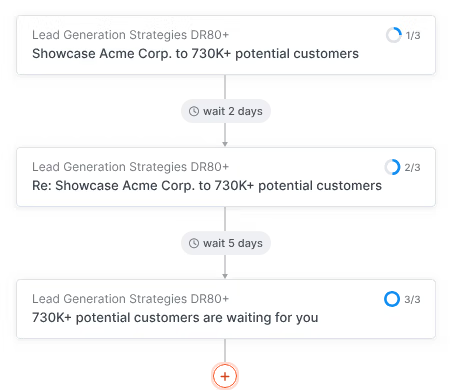
You can also create alternative email sequences for your sales executives to choose between. A discerning seller can gauge the situation at hand and decide which follow-up sequence to initiate.
Retention
The retention stage of your sales cycle ensures customer loyalty after the sale. By providing support, great service, and staying in touch, businesses reduce the chances of customers churning and increase their opportunities to upsell.
29. Ask for feedback
There’s no better way to make customers feel cared for than by listening to them. Use ratings, surveys, reviews, testimonials, or a mix of these to solicit customer feedback. Unsolicited feedback is important too, so make special note if a customer reaches out to provide some.
We’re all guilty of only wanting to hear positive comments, and that bias sometimes (subconsciously) creeps into our questionnaires. So, ask specific questions, not leading ones. “What is the one feature or functionality you’d like to see in our product?” and “Which feature do you use the most and why?”
At every step, be very clear that their feedback is not just appreciated but vital to your business. When you get honest feedback, reward the client by thanking them and utilizing it to refine your product, service, or offer.
30. Create a strong onboarding experience
Provide new clients with a clear roadmap outlining the steps involved in the onboarding process. Break down complex tasks into smaller, manageable steps to avoid overwhelming them.
Assign a technician or customer support executive to the account to iron out any early issues that could arise. Establish direct contact between the customer and the onboarding specialist to enable quicker problem-solving and make them feel valued.
You may also want to invest in building and maintaining an exhaustive knowledge portal containing step-by-step instructions, video tutorials, FAQs, and discussion forums. This allows customers to get the support they need quickly and can provide another feedback loop. For example, if customers are asking the same question over and over or providing the same constructive feedback about some aspect of your product, you can take action against it. This may look like ramping up training materials or adapting your product roadmap.
31. Make the refund process easy
Lots of businesses offer full or partial refunds, only to backtrack on that promise when a customer takes them up on that offer. If you’ve built refunds into your offer to garner trust or credibility, it’s only right to make the process hassle-free.
Provide clear instructions and prompt resolution of refund requests. By honoring your original commitment, you demonstrate transparency, win the respect of both new and old customers, and save yourself from scathing reviews online.
32. Provide a personalized customer experience
Tailor interactions to the customer's preferences to enhance their experience and strengthen loyalty. Provide tailored recommendations based on their industry and company size and modify these according to ongoing use.
If you’re a SaaS company, add personal touches like incorporating their brand colors and logo on the dashboard.
Travel companies can suggest personalized itineraries to customers based on location and stay duration.
Sync your customer communication history across all touchpoints such as website, mobile app, email, phone, social media, and in-store/in-person interactions to better understand your customer's preferences and needs.
Final Thoughts
Optimizing sales processes is a daunting task. Examine your current operations and see which of these tips on finding leads, qualifying them and and nurturing them can help make your sales process more efficient and successful.
With its interactive, insight-rich proposal format, Qwilr provides the data and intelligence you need to close that deal. This, coupled with an intelligent email automation platform like Hunter Campaigns and its email finding and verifying capabilities, you can propel your sales teams to their highest potential.
About the author

Antonio Gabric|Outreach manager at Hunter and Founder at Viralspy
Antonio has been helping SaaS companies grow their organic traffic and revenue through link building. At Hunter, Antonio is leading a link-building and outreach team to build backlinks that move the needle and connect with industry leaders.
Frequently asked questions
ICPs (Ideal Customer Profiles) define broader characteristics like industry, company size, and pain points, while buyer personas are detailed fictionalized identities focusing on job title, demographics, and behavior.
Update and expand your target list at fixed intervals, more frequently for fast-paced sectors, to prioritize accounts with the highest conversion chances.
Lead qualification frameworks help assess leads against specific criteria such as budget, authority, and need, to determine their potential for conversion and justify the pursuit.
Personalization, using details like name, industry, and recent achievements, helps establish trust and relevance, increasing the likelihood of a positive response.
Effective closing tactics include the visualization close, the puppy dog close, offering multiple options, and creating a sense of urgency with now or never offers.
